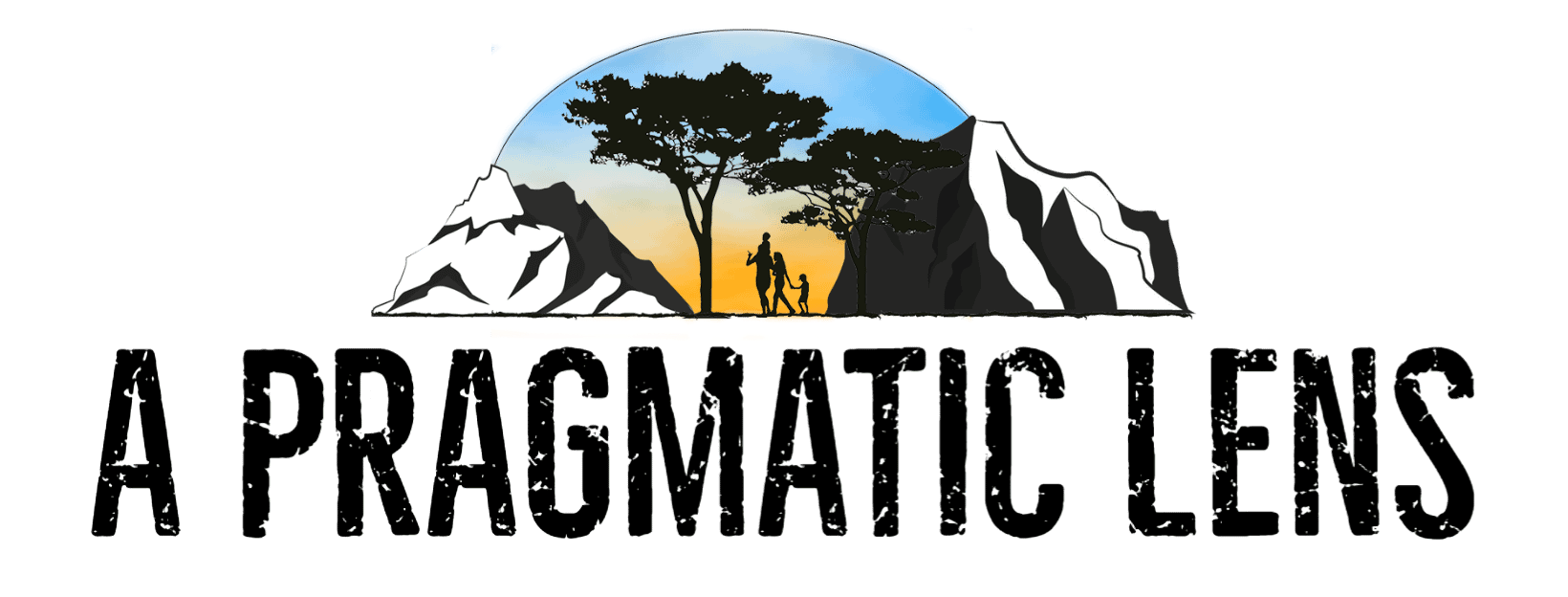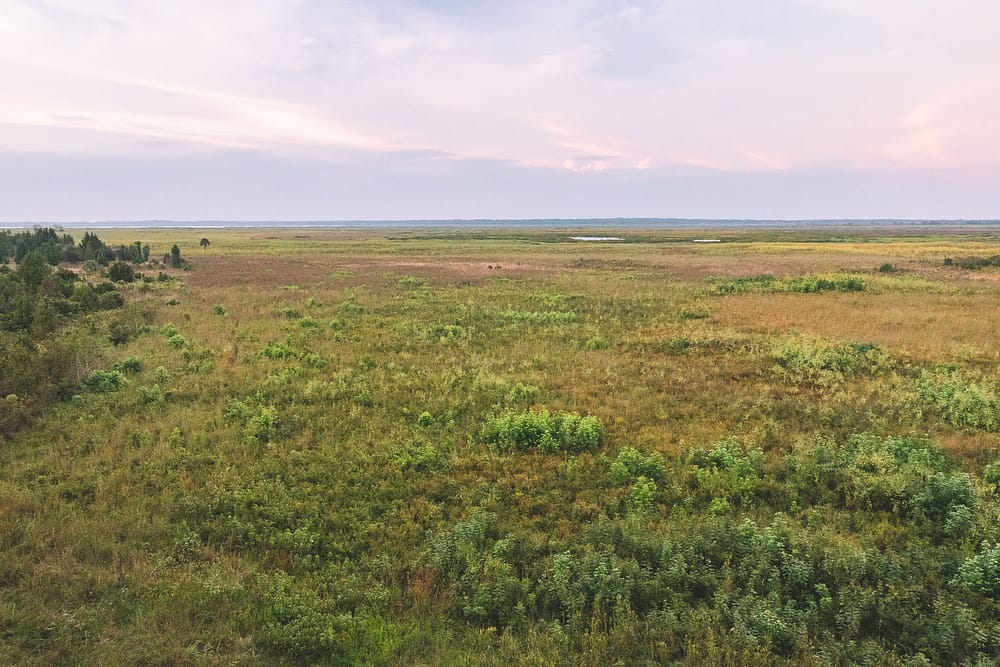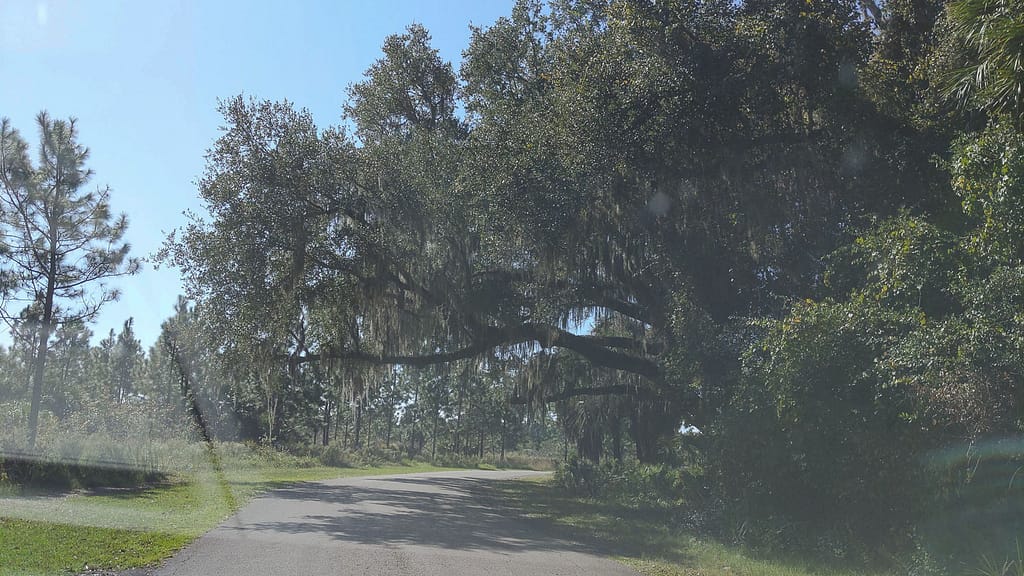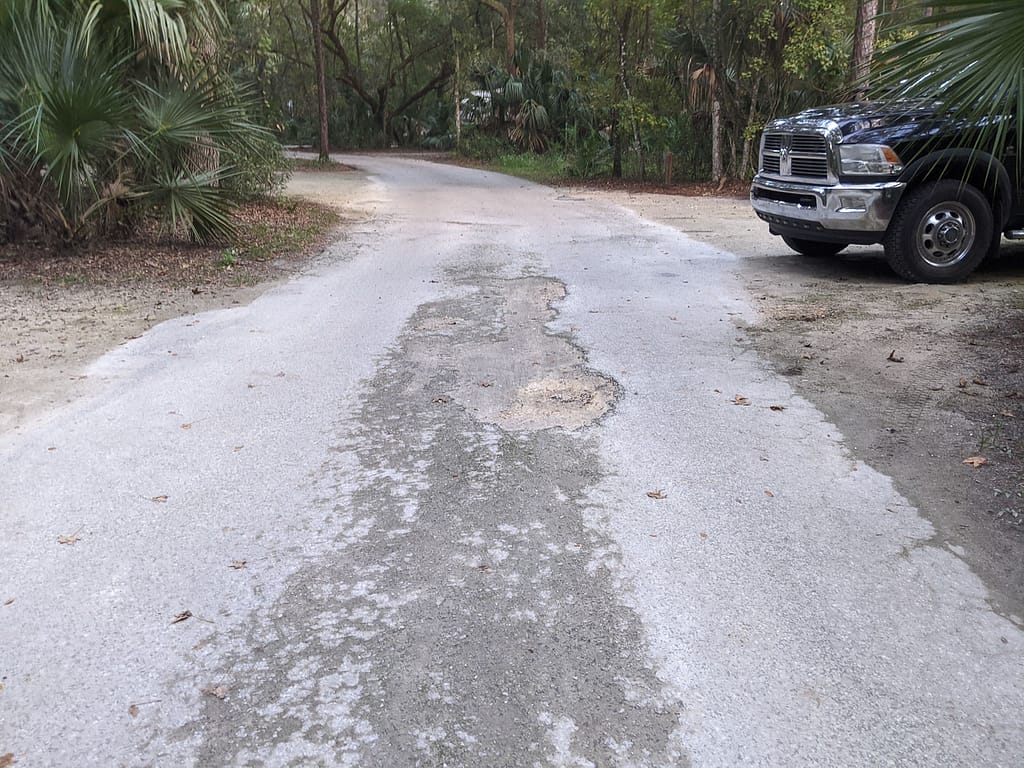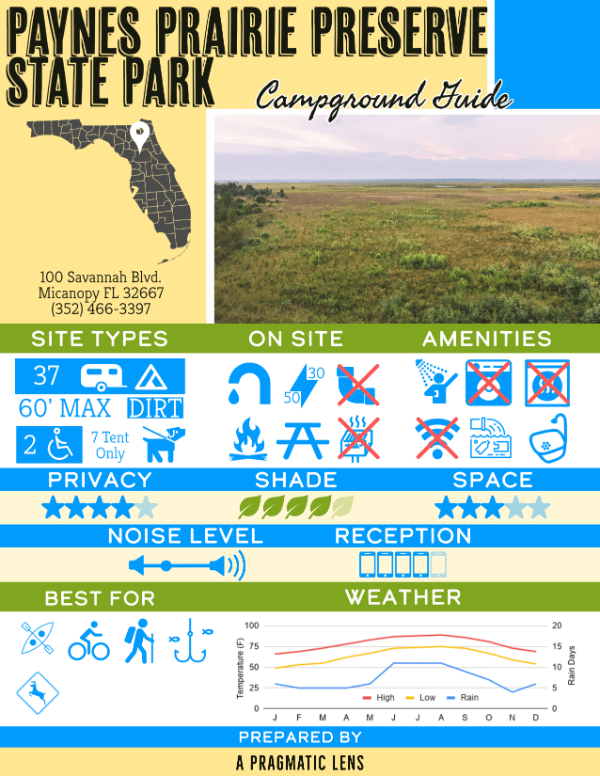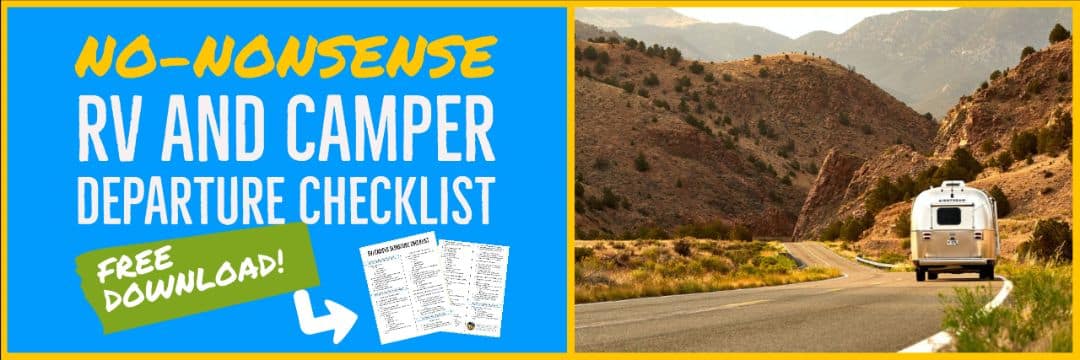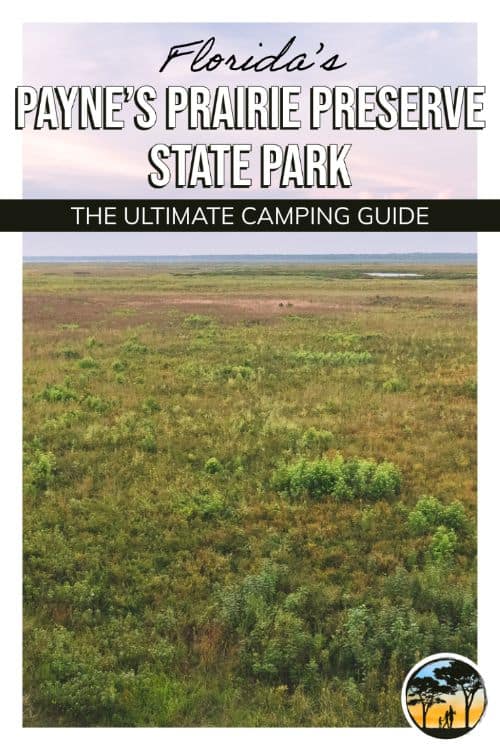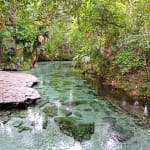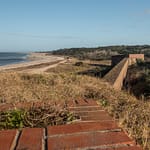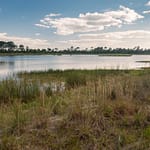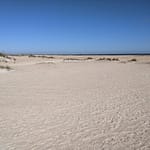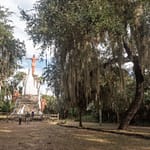If you drive by Payne’s Prairie Preserve State Park, it will make you think twice before camping there. It looks like an endless savanna with hardly any shade. No shade availability is something we avoid because of the relentless Florida sun.
We were SO wrong!
Camping in Payne’s Prairie Preserve was one of the most pleasant experiences we have had, not just in terms of the activities available, but also in terms of understanding the history of the region.
In this article, I share information about what to expect when camping in the preserve. I also share some of the best things to do in and around the park, as well as some interesting facts about Payne’s Prairie Preserve State Park and its diverse and unique wildlife.
Enjoy!
- Payne’s Prairie Preserve State Park – Camping Information
- Puc Puggy Campground
- A quick word about Primitive Camping
- Things to Do at Payne’s Prairie Preserve State Park
- Interesting Information about Payne’s Prairie Preserve
- What to Bring to Paynes Prairie Preserve State Park
- That’s all, folks!
- Additional Links
This post may contain affiliate links. Visit the Disclaimer page for more information.
Payne’s Prairie Preserve State Park – Camping Information
In this first section, I will give you the information you need to know about camping here. Read on!
Directions
Getting to this park is easy! Not only is it right off of the interstate, but there is also one main entrance. You should not have any issues with your GPS taking you there directly.
Here is the address and contact information for Disney’s Fort Wilderness (add this information to our RVenture Ahead Trip Planner if you have it):
Address: 100 Savannah Blvd, Micanopy, FL 32667
Phone Number: 352-545-6000
Payne’s Prairie Preserve State Park Map
With 21,000 acres of savanna, you better keep a map handy! This is the map you will receive when you check-in. If you click on the image, a PDF version will open up so that you can download it and keep it handy.
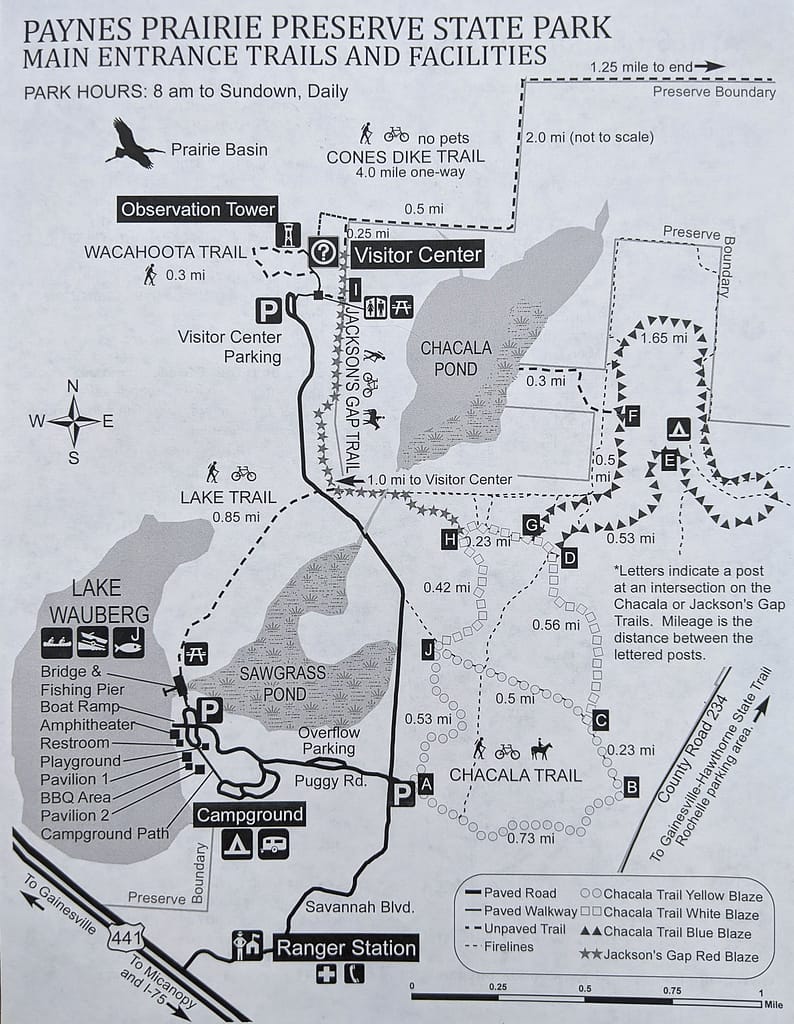
Checkin in
We visited this park in October of 2020. Because of this, there is no requirement to get out of your car. Because online payment is now required, all you need to do is provide your name. It also helps to know your site number. Make sure you ask for a map!
The Roads
The road to the campgrounds and around the campground loop is paved and in decent condition. There are some potholes, but they are not too bad.
The roads are a bit narrow in parts and also lined with magnificent oak trees. As beautiful as they are, do know that there are some scary looking low-hanging branches. Yet, I saw plenty of tall class A motorhomes and fifth-wheels, so the low hanging branches should not be an issue.
Puc Puggy Campground
Feel free to use the code below to share this infographic on your website!
<p><strong>Please include attribution to https://apragmaticlens.com/ with this graphic.</strong><br /><br /><a href='https://apragmaticlens.com/paynes-prairie-preserve-state-park/'><img src='https://ml0cur3zhy5j.i.optimole.com/w:auto/h:auto/q:mauto/ig:avif/f:best/https://apragmaticlens.com/wp-content/uploads/2021/06/Paynes-Prairie-State-Park-Info.jpg' alt='Camping information summary for Paynes Prairie Preserve State Park' width='600px' border='0' /></a></p>Puc Puggy consists of just one campground loop area. With only 37 campsites, it is rather small. It is located in an oak hammock, providing plenty of dry ground, shade, and privacy.
The Campsites
There are 30 RV/tent sites and 7 tent-only sites. At $18 per night, this campground is one of the cheapest in the State Park system.
Tent Sites
The tent-only sites are located in a small loop on their own. You will park your vehicle in a nearby parking area and walk your gear the rest of the way. But have no fear. It is pretty close.
What I like about this setup is that it gives tent campers the feeling of being further immersed in nature. And if you have little kids, it is nice knowing that they can play without being right on the road.
Tent sites also have basic amenities such as water and electricity. The bathhouses are also fairly close.
RV/Tent Sites
As for the RV/tent sites, most are a bit on the smaller side, but quite a few are still able to accommodate large rigs.
The ground is a mix of packed dirt, limestone, and gravel. Unless your RV has an auto-leveling system, expect to do some leveling of your own. We used the curved levelers for the first time, and they worked like a charm! So much easier than using wooden blocks.
One thing to keep an eye out for is large pebbles on the ground. A large pebble was pinching one of our tires, so we ended up having to move our rig to get the large pebble out from under it. So, before you settle where you want your rig placed, walk around and make sure there are no large pebbles!
Most sites had plenty of shade and privacy, and it is nice to know that for the most part, you cannot go wrong here.
Best Sites
The best sites for privacy are 6 (45 ft, 30amp), 11 (45ft, 30 amp), and 18 (50ft, 30 amp). The passenger side of your camper faces a mostly wooded area, which means you should not have any issues enjoying some peace and quiet.
If you want lots of space, then consider staying in site 36. It is 55ft long and plenty wide, giving you lots of room to stretch. It also has 50 amp power.
Worst Sites
Most sites are quite nice and you will probably not go wrong. All I would highlight is that if you want as much privacy as possible, avoid sites that face the inside of the loop. You will probably get glimpses of your neighbors!
The Bathhouses
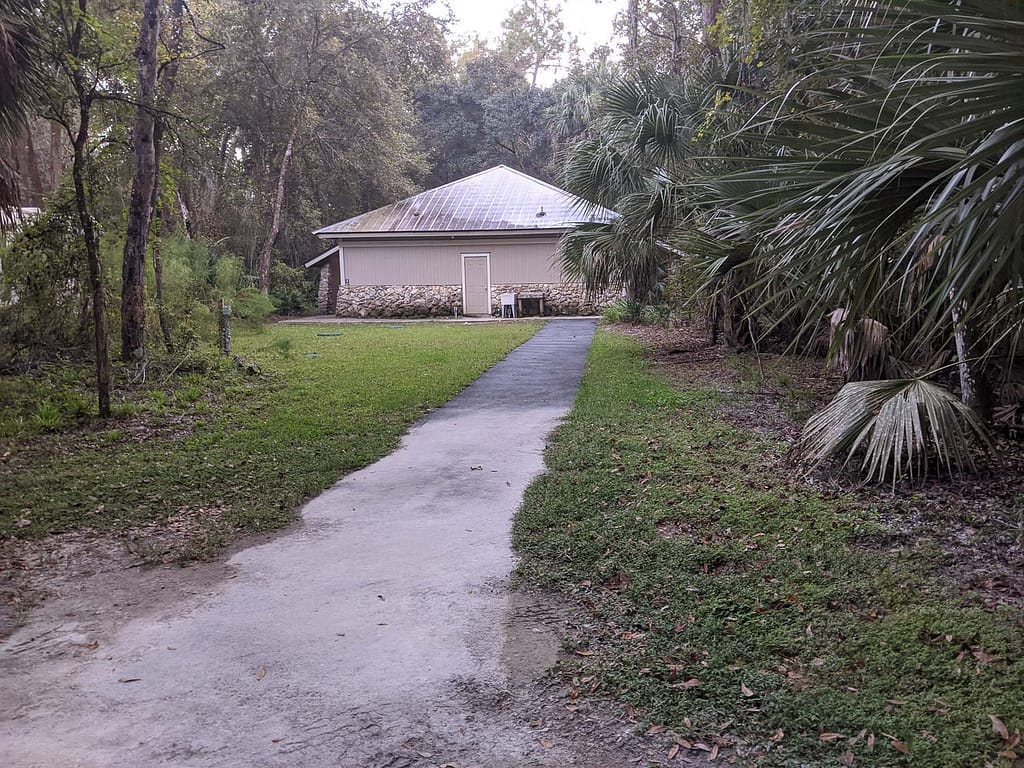
I was surprised to see two bathhouses, considering this is a small campground. The facilities are rather old and basic, but they were clean and well-maintained.
Laundry and Facilities
There is no laundry that I could see in the bathhouses. However, both bathhouses do have a large sink for dishwashing. You could also use the sinks to wash small garments if needed.
Just know that there is no dryer, so make sure you have a clothesline. I have been using these stretchy braided clotheslines because they do not need pins and the hook-and-loop ends make it easy to set up.
Related: Rainbow Springs State Park Campground Review and Things to Do
WiFi and Cell Phone Reception
I was surprised to see that the cell phone reception was quite decent. Our phones are on the AT&T and Sprint networks, and they all worked well. I also use a Verizon hotspot for work, which had plenty of signals and allowed me to access the internet without any issues.
Hookups and Dump Station
All sites have easy-to-reach water connection with decent pressure. All sites also have power, most with 30 amp, a handful with 50 amp. Make sure you add this requirement as a filter when choosing your sites.
There are no sewer hookups at the sites, so you will need to use the dump station. The dump station, which for some reason is not added to the map, is located just past site 50. It is a single lane dump station and it is well-maintained. The dumpster and recycling bins are also located in this area.
Pets
Pets are allowed in all camping areas. You must keep your furry baby on a 6ft leash at all times, and pets must be quiet. Pets are allowed in some trails and paths but there are some trails where pets are not allowed due to wildlife encounters.
Getting Around
The campgrounds itself is small, and for the most part, you will be able to get to nearby amenities on foot. Having a bike will allow you to reach some trails that are further out.
If you want to get the most out of this park, however, you will need a vehicle. Some of the better trails are farther away. Some are even in different parks.
For that reason, if you have a motorhome, make sure you tow a vehicle to help you get around.
A quick word about Primitive Camping
If you are the more adventurous type, there are other options for you.
There is a primitive campground that can be accessed on foot, bike, or horse about 1.85 miles along the Chacala Trail. Because of the distance, campers are required to check in 2 hours prior to sundown.
There are three tent pads, a campfire ring, a waterless bathroom, horse hitching area, and non-potable water.
Things to Do at Payne’s Prairie Preserve State Park
This park is the perfect destination for nature and wildlife lovers, as most of the activities are geared toward outdoor adventures.
Hiking Trails
There are tons of trails in the park and around. Take a look at the map below, and continue reading for further

Wacahoota Trail
To get to this trail, you will need to drive to the visitor center. This is a short and easy 0.3-mile trail that leads to a 50ft observation tower. It is a great trail to do near sunset. Just make sure you head back to your vehicle before dark.

The walk from the visitor center to the observation tower is paved, which is great for accessibility. The rest of the Wacahoota Trail is not paved.
From the observation tower we were able to spot wild horses and cattle, which are the descendants from the andalusian cows and horses brought over by the Spanish in the 1500s.
Lakes Trail
This 0.85-mile trail is fairly easy to reach from the campground. You would just walk the campground path toward the fishing pier, and continue from there!
Cone Dikes Trail
This is a long 8-mile trail. No pets are allowed on this trail because you are going deep into the prairie and you may encounter wild horses and bison!
Be aware that this trail is out in the open and there is no shade or shelter. Make sure you check the weather, start early, and pack provisions accordingly. The last thing you want is to become dehydrated or get caught in a lightning storm in the middle of the prairie!
You can download our free Hiking Safety Guide here.
A shorter 1.6-mile trail, Jackson’s Gap, connects the Cone Dikes Trail with the Chacala Trail.
Chacala trail
There are multiple blazes you can follow, and this trail can be up to 6.5 miles long if you decide to explore all the loops!
We only explored the beginning of the trail, and here are our observations:
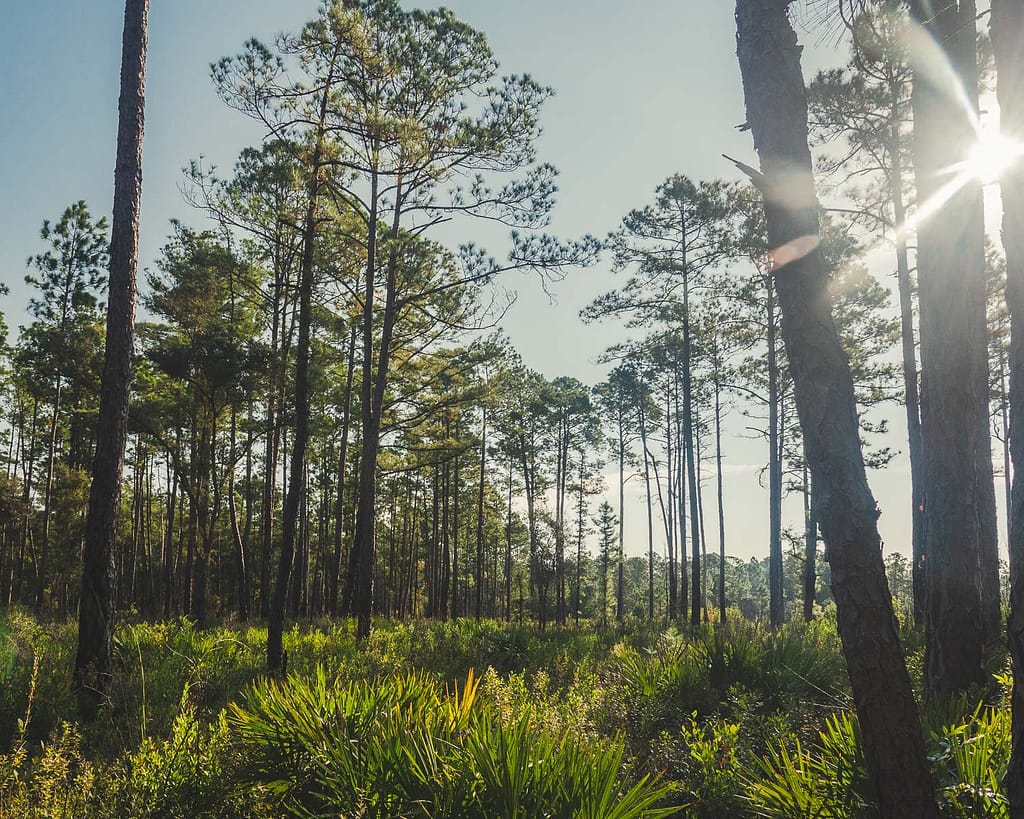
The hike from A to H is easy, with some sections going through a beautiful slash pine hammock. This section can be a bit sunny at times.
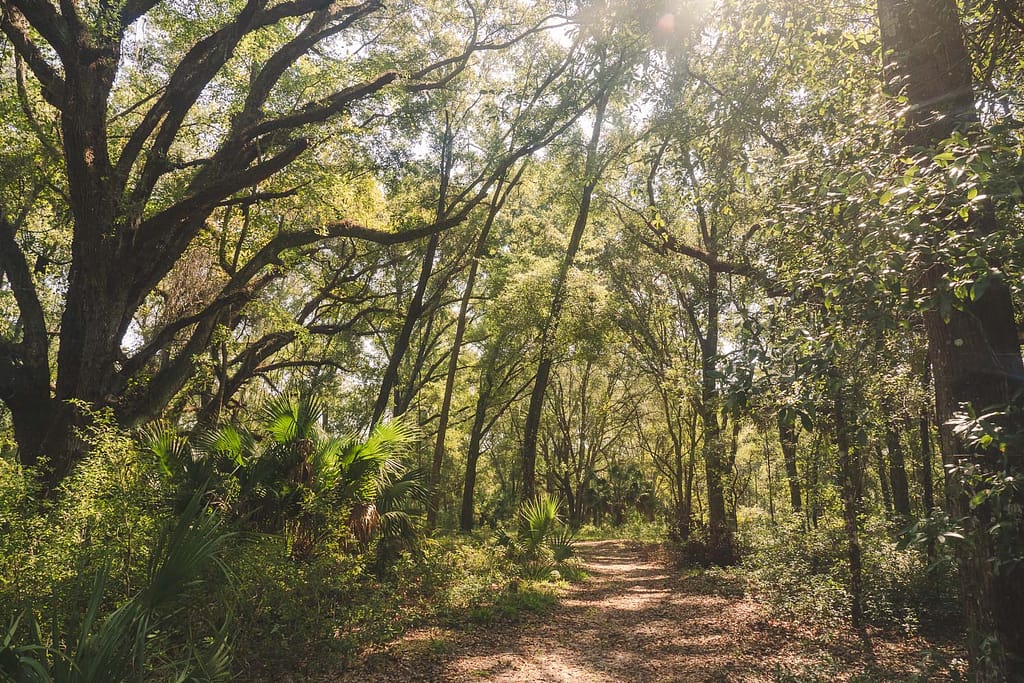
The hike from A to B is a bit more oaky and shady. It is also wider at parts and overall, I thought it was just prettier. If you only plan to explore a short portion of the Chacale Trail, I recommend you try this portion.
La Chua Trail
Access to this trail will require you to leave the park, but it is worth it. You can also access this trail from the Gainesville-Hawthorne trail (more on this on the biking sections).
The trail goes through an old archway and some old stables.
From there, the trail starts as a boardwalk overlooking the Alachua sink. Notice that it is a fairly long boardwalk with no shade, except for a few sheltered areas. There are lots of wading birds here, including limpkins, great egrets, and little blue herons.
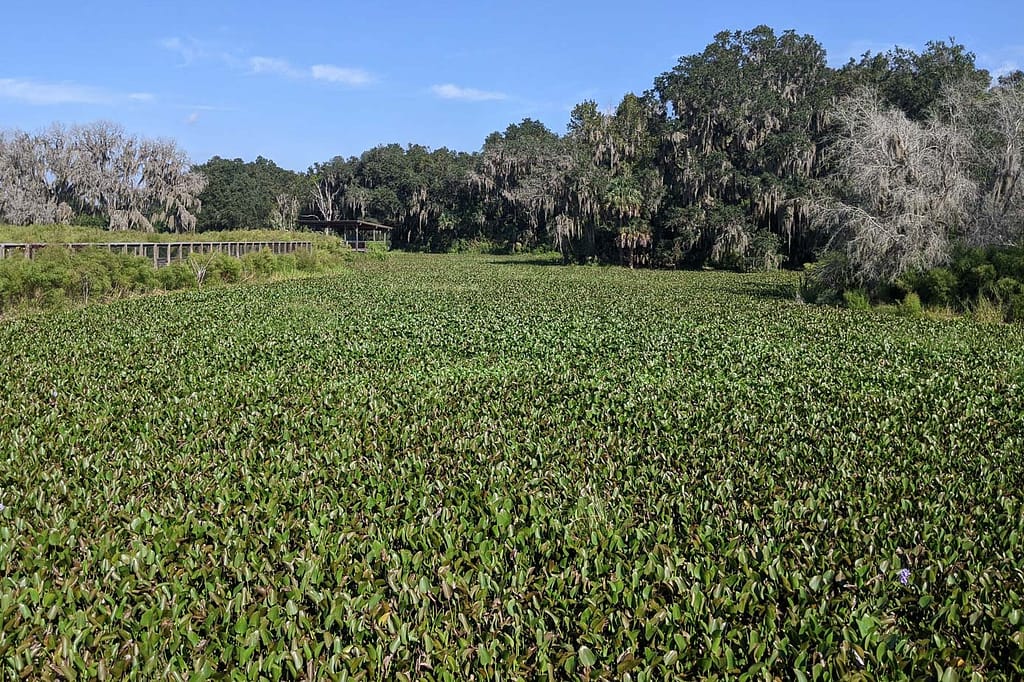
After the boardwalk, the trail turns into the prairie. This portion goes on for many miles and there is no shade. If this is something you want to explore, make sure you start early in the morning, bring plenty of hydration, and plenty of sunscreen. Also check what the conditions of the trail are, because they are prone to flooding.
Bolen Bluff Trail
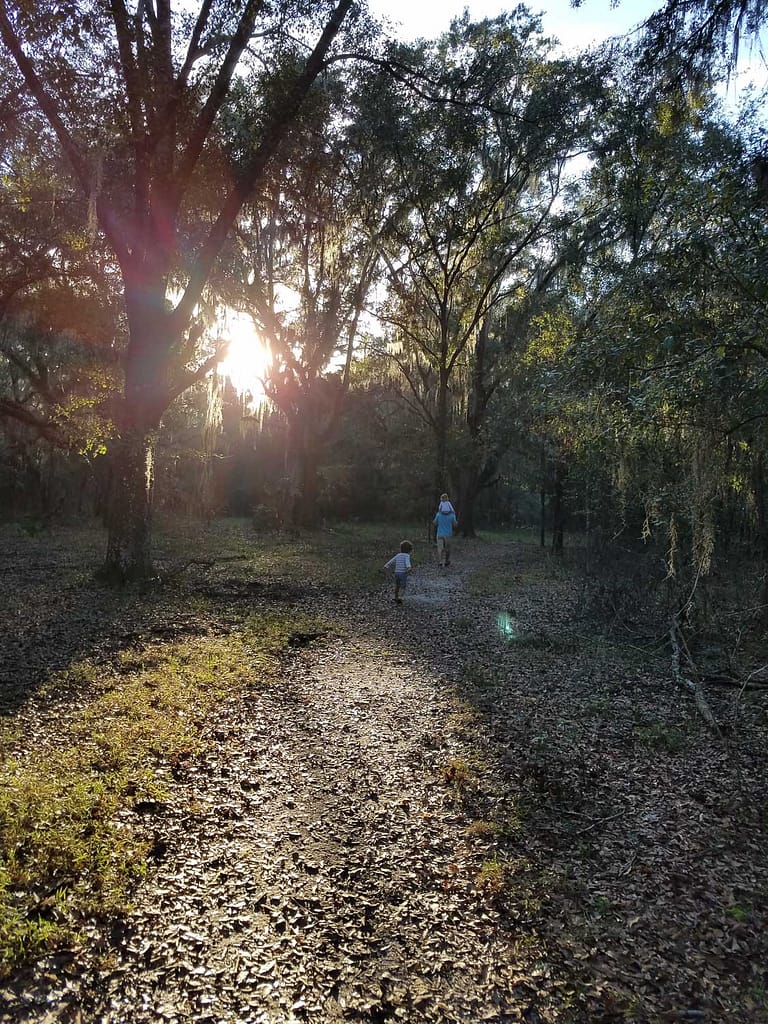
This is a gorgeous, shady trail that you can access from 441. A short 2.5-mile trail that leads to an observation tower to enjoy the grand views of the prairie. Pets are not allowed here.
Biking
Gainesville Hawthorne Bike Trail
Historically a train track, this is a nice, 16-mile long trail for jogging or biking.
The Gainesville-Hawthorne trail is a separate state park altogether, so you will need to drive out of Payne’s Prairie Preserve to access this trail. Luckily, there are no extra fees that you will need to pay to access it.
There are four different trailheads where you can access this trail. We started off at the Boulware Springs Park, where there is also a historic building with a spring house.
Be ready for some uphill pedaling at some points, so make sure you have a good bike with gears or a bike with electric assist. And wear a helmet!
We made it to the Alachua Lake overlook, which was about 2.5 miles from our starting point. It is a shady boardwalk with a bench overlooking the lake, which makes it a nice place to rest and enjoy a snack.
There are multiple trailheads you can access from the Hawthorne bike trail, including the La Chua trail explained above. One cool feature about this trail is that it has bike repair stations next to a few of the trailheads.
Related: Camping at Disney’s Fort Wilderness – The Ultimate Guide
Other Biking Trails
You can also bike along many of the hiking trails in the park such as Chacala Trail, Bolen Bluff Trails, Jackson’s Gap, Cone’s Dike Trail. Keep in mind that the soft ground will probably require fat-tire bikes and some strong quads to make it happen.
Fishing
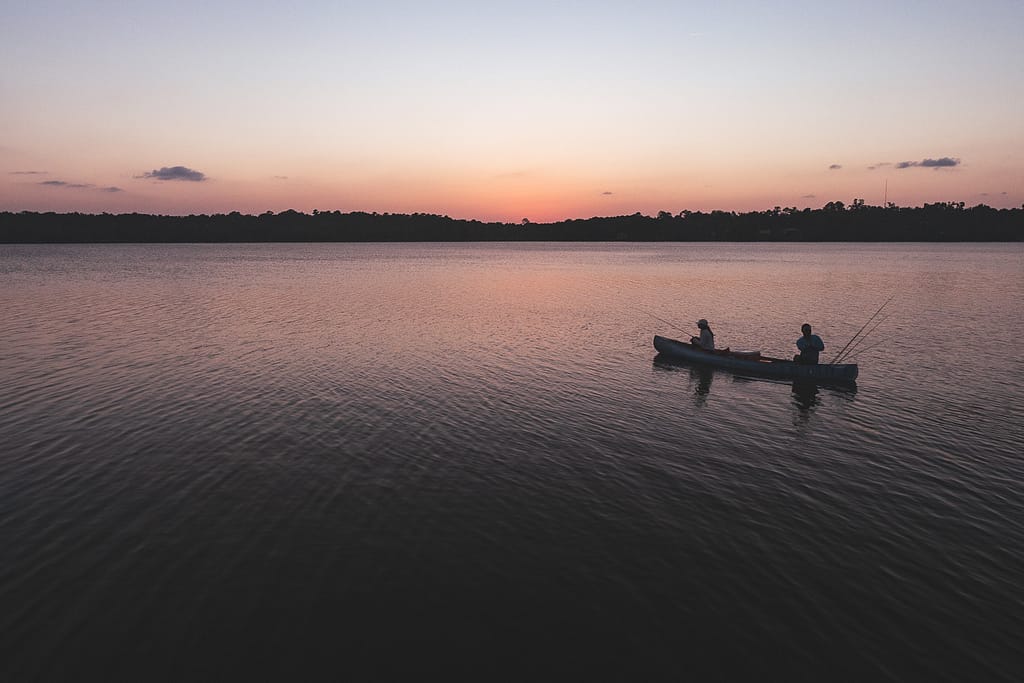
Fishing is available from the pier over Lake Wauberg. It is certainly a great way to spend the last hour of daytime, as the sunset views here are quite stunning!
Kayaking and Canoeing
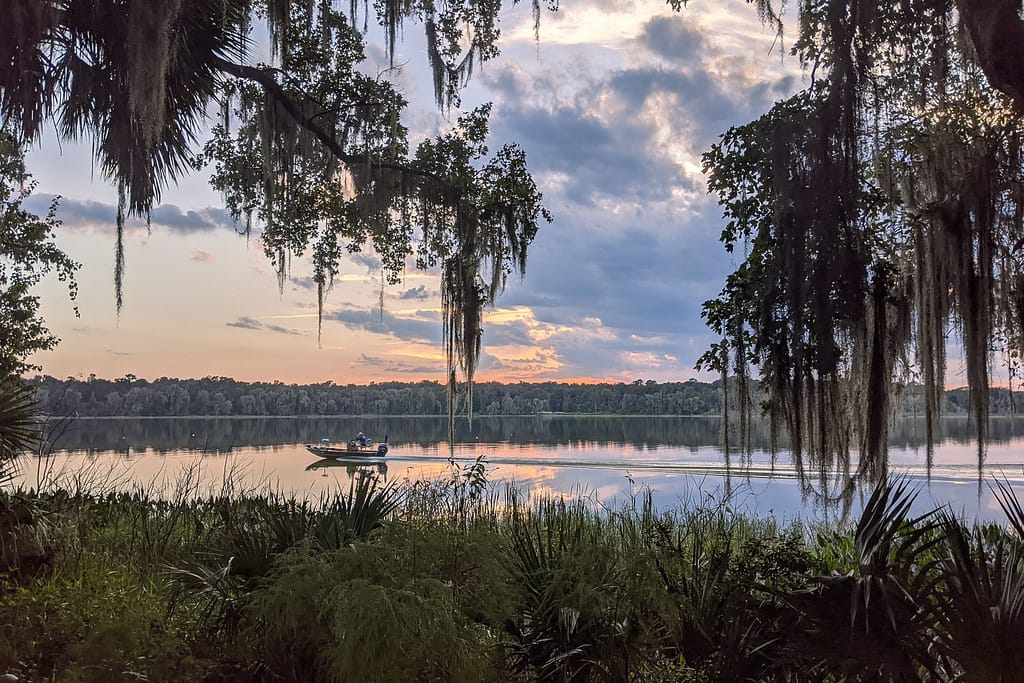
There is a boat ramp on Lake Wauberg for easy launching of kayaks and canoes. This will allow you to paddle and fish over 300 acres of lake area!
We did not bring our kayaks, but bringing our inflatable ones probably would not have been the best idea. The alligators in this lake are quite large, so ensure you have a sturdy and stable boat!
Related: Silver Springs State Park – A Unique Camping Experience
Enjoy the sunset
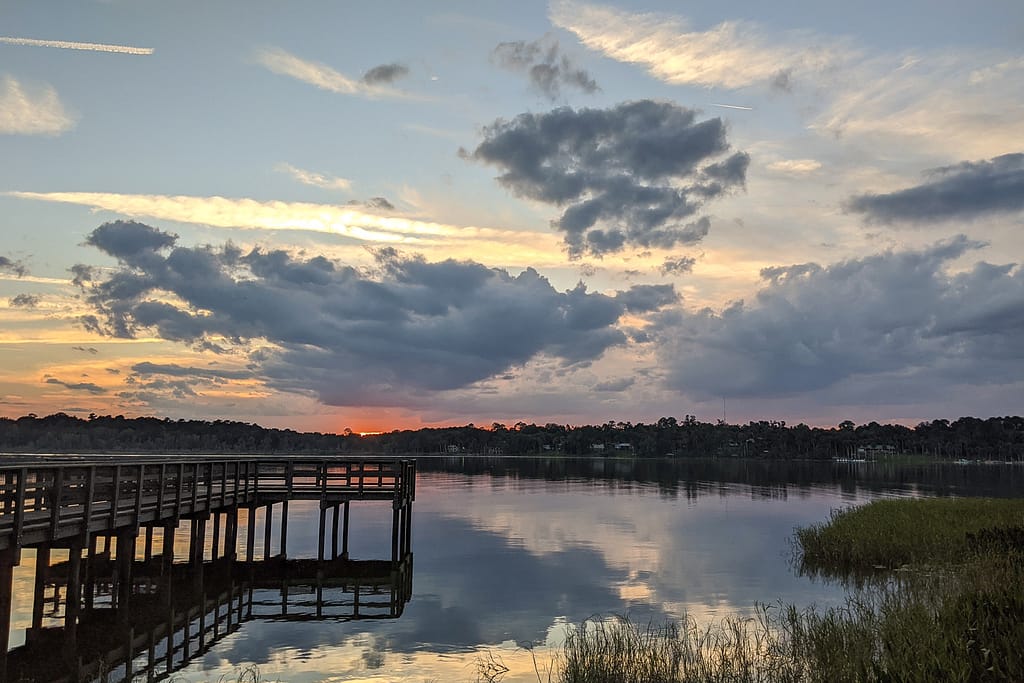
Sunsets over Lake Wauberg are simply stunning. Make sure you head over to the pier about 30 minutes before sundown to enjoy the best colors.
If lake views are not your thing, then drive over to the observation tower by the visitor center! Then you will get to enjoy stunning sunset vistas over the large prairie expanse. If you are lucky, you may hear sandhill cranes and bald eagles, and barred owls. If you are very lucky, you may even get to see wild horses or bison!
Playground
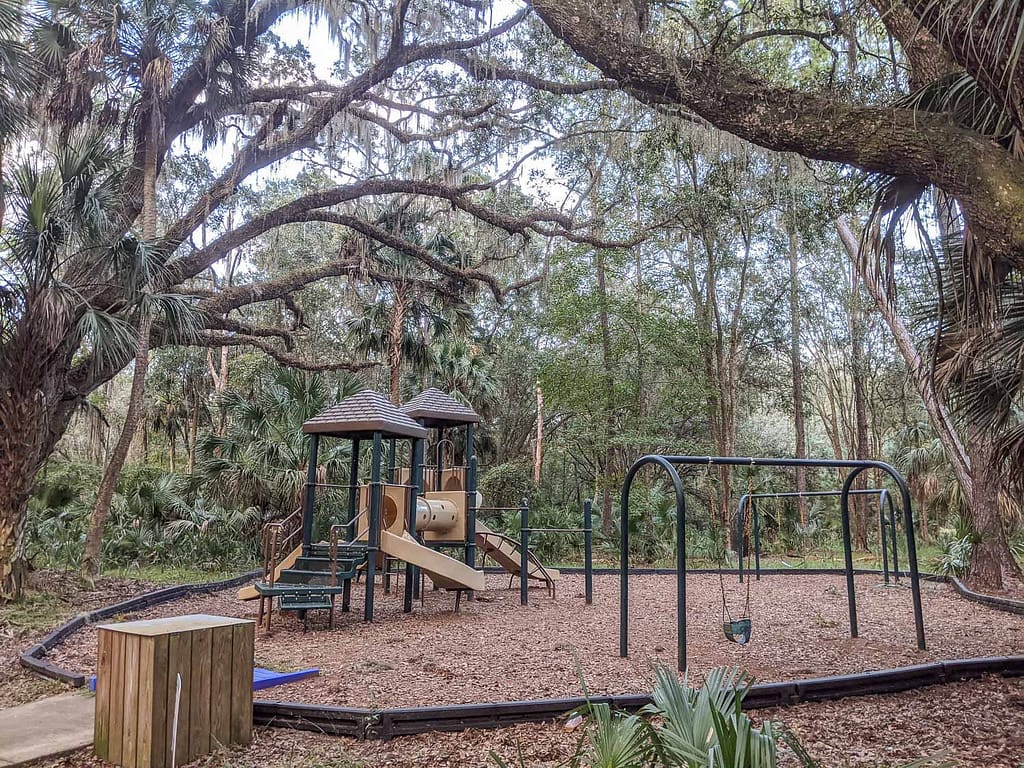
There is a fairly large playground right by the campground path as you approach the recreation area. It is surrounded by gorgeous oak trees that provide quite a bit of shade.
Learn the History
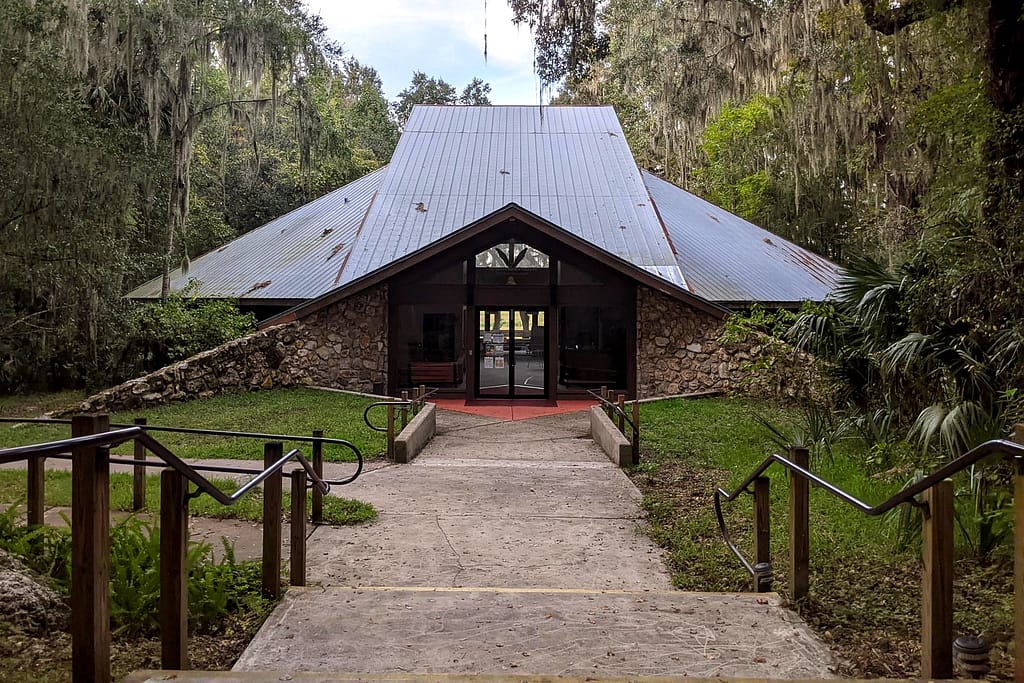
Designated a National Natural Landmark, this park was Florida’s First State Preserve. You can learn more about the history of this preserve in the Visitor Center. In here you will find exhibits and information about the parks native flora and fauna, as well as a film explaining how everything came to be called “A Level Green Plain”
A short, paved walk from the visitor center will lead you to the 50-ft tall observation tower, which is yet another wonderful spot to watch the sunset.
Interesting Information about Payne’s Prairie Preserve
Are there bison at Payne’s Prairie?
Short answer is…yes! There are bison in this expansive prairie, but they are certainly difficult to see. You may catch a glimpse of them from one of the observation towers, but you are more likely to see them if you go on one of the long prairie trails, such as the Cone Dikes or La Chua trail.
Are bison native to Florida?
The herds of bison currently inhabiting Payne’s Prairie are descendants of a reintroduction attempt in the 1970s. At that time, 10 bison were brought over from the Wichita Mountains in Oklahoma.
The reason bison was reintroduced was because of historic accounts of bison herds present in the prairie over 200 years ago. The historic record indicates that these original herds were hunted down to extinction in the late 1700s.
Why is Payne’s Prairie flooded?
Payne’s Prairie, which for several years remained fairly dry and quite accessible, has not been flooded since late 2017. The reason is because Hurricane Irma dumped so much rain that left the prairie looking like a giant lake.
While this had short term repercussions for wildlife, and it certainly limits accessibility to some trails, this is actually part of the natural flow of the prairie. As a result, the high water is helping in terms of controlling the growth of invasive plant species that are not adapted to these flooded conditions.
How was Payne’s Prairie formed?
Several sinkholes were close together and eventually merged, forming what is nowadays the prairie basin. This basin has alternated between wet periods when the basin is simply a lake, and dry periods of prairie.
When did Payne’s Prairie drain?
The Alachua Sink is where the prairie water drains through the limestone. According to historic accounts, these periods of draining happen quite rapidly. As far as I can tell, the last time a large “draining event” occurred was about 100 years ago.
Related: Kissimmee Prairie Preserve State Park Campground Review
What to Bring to Paynes Prairie Preserve State Park
To get the most out of your time here, and depending on your own interests and hobbies, here is what I recommend you bring:
That’s all, folks!
Payne’s Prairie Preserve offers visitors and campers a taste of old Florida, providing a much better understanding of the history of this region and Florida in general. It certainly differs from what most people think of Florida: basically a combination of swamp and beaches.
A geological marvel itself, Payne’s Prairie Preserve will give you a new appreciation of the complex geological, biological, and anthropological history that has shaped Florida during the past 500 years.
I hope you found this short review useful when planning your camping trip to Payne’s Prairie Preserve State Park. And of course, if you have been here in the past and have useful information for our readers, make sure you drop a comment below!

